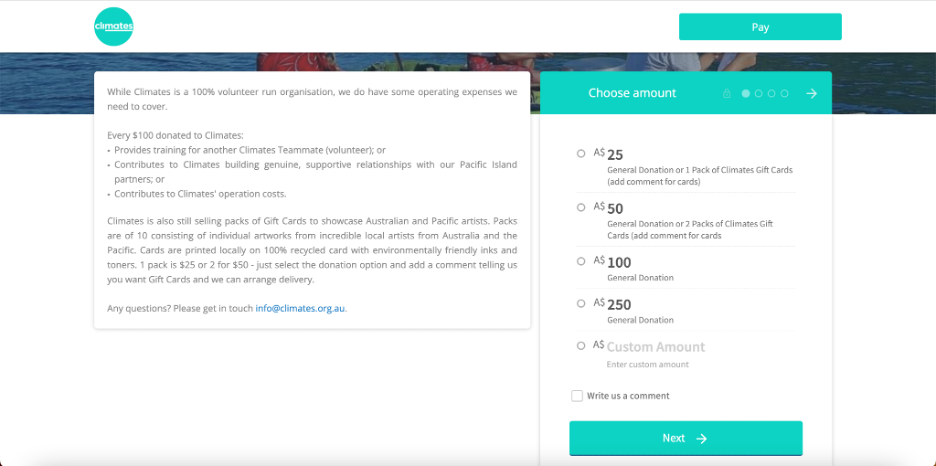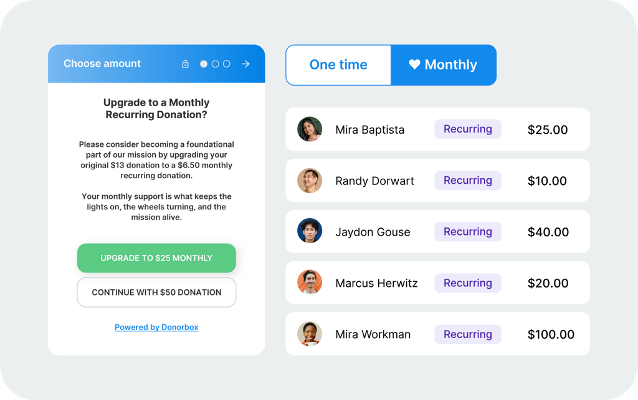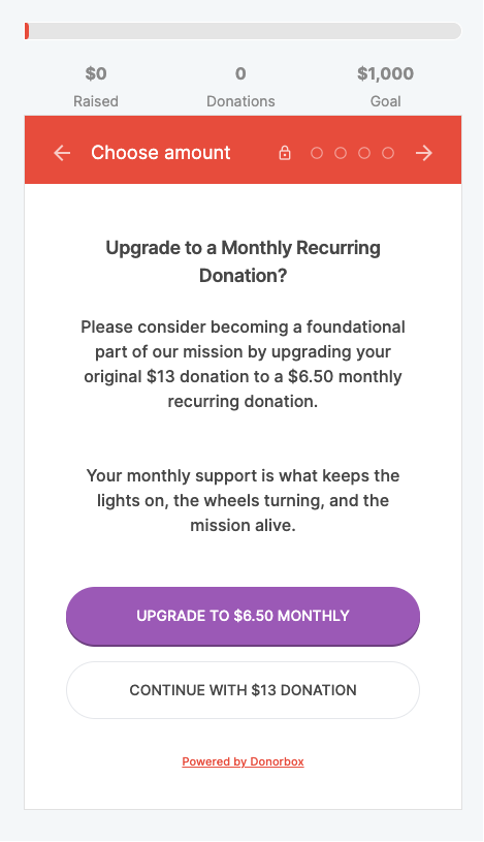 The impact of a single donation is undeniable, but building a sustainable stream of income for your cause requires a strong strategy that goes beyond one-time donations. Fundraising upsells and cross-sells are great tools to include in your strategy and when used correctly, they can significantly increase regular giving.
The impact of a single donation is undeniable, but building a sustainable stream of income for your cause requires a strong strategy that goes beyond one-time donations. Fundraising upsells and cross-sells are great tools to include in your strategy and when used correctly, they can significantly increase regular giving.
Did you know that regular donors give 42% more annually, compared to one-time donations?
However, converting one-time donors to monthly givers can be quite daunting. While many organizations rely on tools like memberships, recurring donation drives, or reward programs to drive monthly donations, most overlook the power of upselling and cross-selling.
In fact, only 16% of nonprofit organizations have a pop-up on their one-time donation page to inspire one-time donors to become monthly donors.
Keep reading to explore what fundraising upselling and cross-selling are, the different types of upselling, and how Donorbox takes the guesswork out of enabling recurring upsells.
Cross-Selling vs. Upselling
Cross-selling and upselling are different approaches with the same goal: to increase your fundraising income.
When we talk about upselling, the approach is almost always focused on increasing the amount your donor initially planned to give. Ignoring the potential of fundraising upsells means that you’re potentially leaving money on the table.
While upselling is designed to increase the initial donation, cross-selling offers your donors something separate in addition to the gift they planned to make. For example, your organization might host a gala dinner and in addition to the ticket sales, you could add a raffle or drinks coupon before the ticket checkout.
Both can be incredibly powerful fundraising tools, but they must be done correctly. Let’s look at each in more detail.
What is a Fundraising Cross-sell?
As previously mentioned, cross-selling isn’t about replacing the donation or gift your donor is about to make, it’s about offering them something in addition to it. The goal is to increase the total value of their donation.
In order to create a strong cross-sell strategy, you need to analyze your donor base. Understanding when and how they give will enable you to offer them a meaningful way to support your cause. The cross-sell should always add value to their donation experience and bring them closer to your mission.
This all sounds great in theory, but how do you implement this? Well, there are a few different ways nonprofits can leverage cross-selling.
Different Types of Cross-Selling
Events

No matter your ticket pricing strategy, you can raise critical funds by asking attendees to donate on top of their ticket purchase. Offering free tickets? Request that supporters make a gift to help your cause in place of a ticket fee.
This makes it easy for your event attendees to directly support your mission. Plus, you can announce the amount you’ve already raised at the start of the event!
Branded Merchandise and Products
Adding products to your cross-selling strategy can help boost your fundraising. The promise of receiving a fun item adds an extra incentive for donors to support you.
Product fundraising is also an excellent addition to fundraising events as it can significantly increase overall funds raised for the event. You can sell products at your event and when you sell tickets leading up to the big day.
Campaign-Specific Cross-sells
Consider the programs you’re raising funds for, do any of them stand out as being especially good opportunities for branded merchandise or products? Why not create a separate cross-sell campaign for that program? This can also be a great way to test the efficacy of your cross-sell strategy without redesigning your entire donation page.
Take it one step further by commissioning local artists to create designs you can print on cards, mugs, or t-shirts.

Check out how Climates sold cards of artworks from Australia and the Pacific. They set up their Donorbox donation form with different donation levels that act either as general donations or as levels to purchase one or two packs of cards.
What is a Fundraising Upsell?
Upselling is a term often used in retail marketing but remains quite new to the nonprofit world. A fundraising upsell is an invitation you extend to your donor to increase the amount of their existing gift or make a recurring gift.
It can offer many great opportunities for your donors to make a more significant impact on your mission, and for your organization to increase its fundraising income. Regardless of the tools used to deliver the upsell, at its core, a fundraising upsell makes it easier for your donors to exercise greater generosity.
When it comes to nonprofit fundraising, there are a few different ways your organization can leverage upselling. Let’s take a look at some of the more impactful solutions.
Different Types of Upselling
You’ve probably found that your organization has spent significant time and resources building your brand recognition and reaching new donors. But how much focus have you placed on increasing your existing donation amounts, and generating more revenue from supporters already donating to your cause?
Finding new donors can be far more resource-intensive than growing the income generated from your existing donor base. That’s exactly why taking a more considered and strategic approach to upselling can make a huge difference to your fundraising income.
But where do you start? Here are some of the more popular fundraising upselling techniques.
Amount upsell

As the name suggests, “amount upsells” usually ask the donor to give a little more after they have completed their initial donation. This could mean asking your donors to cover the payment processing fees.
Processing fees add up, and nonprofits typically only receive around $98 from a $100 credit card donation. Many donors may not even realize that fees are taken out of their donation if you don’t tell them.
Gift matching
Another great upselling tool that grows your donor and partnership base is gift matching. If your nonprofit doesn’t have a seamless donor match system in place you’re possibly missing out on a huge boost in gift revenue.
Did you know an estimated four to seven billion dollars in matching gift donations go unclaimed every year?
When nonprofits help companies match donations made by employees, they build a relationship with the corporate social responsibility department of that company. This relationship can lead to corporate-nonprofit partnerships, fundraising event sponsorship, grants, a gift program, and more.
A corporate matching gift doesn’t have to be complicated. We know what you might be thinking – that it’s a long and tedious process! But no, with Donorbox and 360MatchPro, it’s a breeze! For you and your donors. Your nonprofit can double or even triple donations with just a few simple steps.
Recurring upsell
Online fundraising platforms have made it easier than ever to gather donations but driving recurring donations can still be a challenge for some organizations. Using a recurring upsell tool can make it easier for your one-time donors to give regularly.
We know that regular, dependable giving offers organizations like yours the stability they need to focus on their mission and impact. But building this base of sustainable support takes time, and can be resource-intensive. Donors supporting your organization for the first time or with a single donation are well-placed for cross-sell and upsell campaigns — they’ve already taken the first step!
The good news is that Donorbox has simplified this process, keep reading to find out more.
Donorbox’s Recurring Upsell Feature

Maintaining a steady and sustainable stream of donations doesn’t have to be difficult and with Donorbox’s Recurring Upsell feature, it isn’t. Donorbox Premium users can now seamlessly convert one-time supporters into regular givers.
With Recurring Upsell you can enable your donation form to prompt supporters to become recurring donors, giving a lower amount, consistently. This optional feature can help you easily turn one-time donors into frequent supporters.
But how does it work?
Using a simplified framework, rooted in fundraising best practices, our Recurring Upsell feature is designed with the understanding that for recurring upsells to be effective, the ask needs to be small and manageable.
For example, your organization will see more value from a monthly recurring donation of $60 than a single donation of $100.
Recurring Upsell is designed to:
- Target small dollar amounts, increasing the likelihood of donors opting in.
- Convert more donors into recurring donations, when they’re more likely to make this switch – at the point of donation.
When your one-time donor decides to donate an amount equal to or less than $200 on the first step of your donation form and clicks through to the following step, they will be presented with a new option.

The amount of the recurring upsell is calculated automatically depending on the original amount your supporter chose to donate. Donors can choose the new recurring donation amount or move forward with their original donation with the simple click of a button.
Over to you
There are multiple ways your organization can use upselling and cross-selling to boost your fundraising efforts; chances are you’re already doing so without even realizing it. But with Donorbox’s Recurring Upsell feature, all you need to do is check a box, sit back, and watch those recurring donations grow.
This feature is only available on our Donorbox Premium plan, an all-in-one fundraising solution that brings you a team of fundraising superstars and tech wizards to help maximize your donations, build successful fundraising campaigns, and double down on what matters most – your mission!
For fundraising tips and tools, check out Donorbox’s Nonprofit Blog. Subscribe to our newsletter to receive the best of the blog in your inbox every month.
About the Author
Donorbox provides an online fundraising platform enabling individuals and nonprofit organizations to facilitate online donations.






